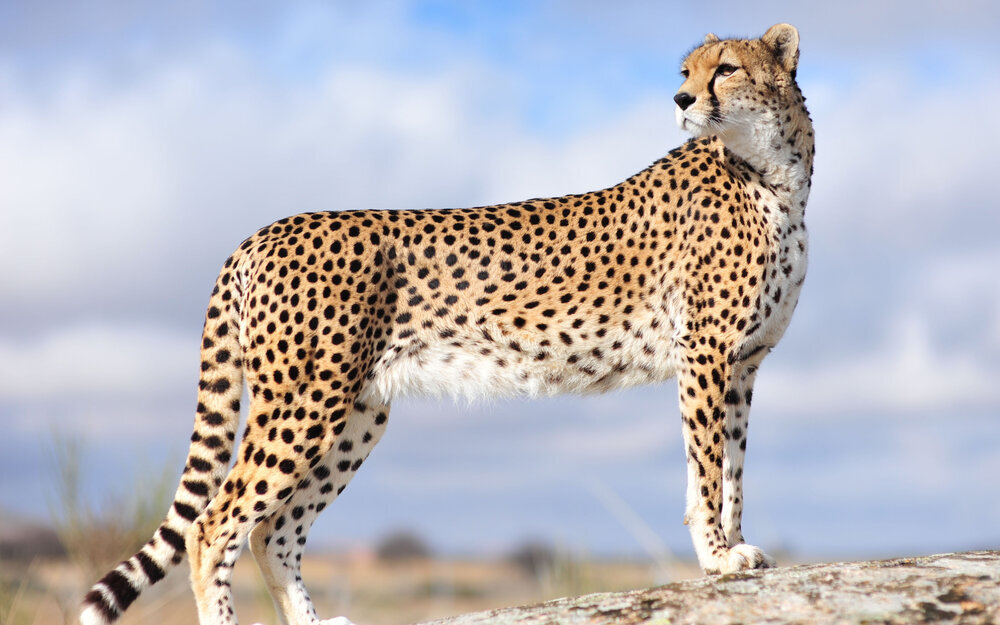The Iranian Cheetah, also known as the Asiatic Cheetah, is a subspecies of the cheetah that is native to Iran. It is estimated that fewer than 50 individuals remain in the wild, making it one of the rarest large cats in the world. This article will explore the unique characteristics of the Iranian Cheetah, the reasons for its decline, and the efforts being made to preserve this magnificent animal.
For a trip to Iran, you need to apply for a prompt Iran Visa.
Characteristics of the Iranian Cheetah
The Iranian Cheetah is smaller and lighter in color than its African counterparts. It has a pale yellow-brown coat with black spots, a slender build, long legs, and a distinctive tear mark running from the corner of its eyes to the side of its nose. The cheetah is known for its incredible speed, capable of running up to speeds of 70 miles per hour in short bursts.
The Iranian Cheetah is an apex predator, feeding primarily on gazelles, wild goats, and other small mammals. They are solitary animals that roam large areas in search of prey, with males having larger territories than females.

Habitat of Cheeta in Iran
It can only be found in Iran which lives mainly in the vast central desert (Dasht-e Kavir) in fragmented pieces of remaining suitable habitat. They mostly live in five sanctuaries: Kavir National Park, Khar Touran National Park, Bafq Protected Area, Daranjir Wildlife Reserve, and Naybandan Wildlife Reserve.
Check and select an Iran tour for your next trip.
Threats to the Iranian Cheetah
The primary threat to the Iranian Cheetah is habitat loss and fragmentation, as well as poaching and hunting. The cheetah’s natural habitat has been severely impacted by human activities such as agriculture and livestock grazing, leading to a significant reduction in prey populations and fragmentation of their habitat. Additionally, poaching and hunting for their skin and body parts have further contributed to their decline.
The Iranian Cheetah is also vulnerable to road accidents, as highways and other infrastructure have been built through their natural habitats. As a result, many cheetahs have been killed or injured by vehicles.

Conservation Efforts
Efforts are being made to conserve the Iranian Cheetah, including habitat restoration, captive breeding programs, and anti-poaching measures. The Cheetah Conservation Fund, a non-profit organization, is working to protect and conserve the cheetah population in Iran and other parts of the world. The organization partners with local communities, governments, and other stakeholders to promote sustainable land use practices and protect cheetah habitats.
Captive breeding programs have been established in Iran to increase the population of Iranian Cheetahs. These programs involve breeding cheetahs in captivity and then releasing them back into the wild. The program has been successful in increasing the population of the Iranian Cheetah, with several captive-bred cheetahs having been released into the wild.
Anti-poaching measures have also been implemented to protect the Iranian Cheetah. This includes increasing patrols in cheetah habitats to deter poachers and confiscating illegal cheetah products.

Last Word
The Iranian Cheetah is a critically endangered subspecies of the cheetah that is native to Iran. Its population has significantly declined due to habitat loss and fragmentation, poaching and hunting, and road accidents. Efforts are being made to conserve the species, including habitat restoration, captive breeding programs, and anti-poaching measures. However, more needs to be done to protect this magnificent animal from extinction.
It’s essential to raise awareness about the threats facing the Iranian Cheetah and work towards its protection and conservation. Through education, research, and conservation efforts, we can ensure that the Iranian Cheetah continues to thrive in its natural habitat and that future generations can appreciate this beautiful and unique animal. Contact us to organize a Cheetah tour for you.
Let us know your ideas or any questions you may have about Iranian Cheetah in the below comment box 🙂


















